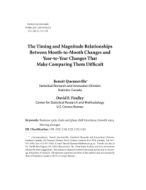
An official website of the United States government
Here’s how you know
Official websites use .gov
A .gov website belongs to an official government organization in the United States.
Secure .gov websites use HTTPS
A lock (
) or https:// means you’ve safely connected to the .gov website. Share sensitive information only on official, secure websites.
-
//
- Census.gov /
- Library /
- Census Working Papers /
- Relationships Between Month-to-Month and Year-to-Year Changes
The Timing and Magnitude Relationships Between Month-to-Month Changes and Year-to-Year Changes That Make Comparing Them Difficult
The Timing and Magnitude Relationships Between Month-to-Month Changes and Year-to-Year Changes That Make Comparing Them Difficult
Abstract
When a monthly economic indicator series contracts sharply for a few months and then starts to recover, the published annual and monthly growth rates can give conflicting signals: the annual growth rate can indicate a decrease and the monthly growth rate an increase or vice versa. This is well known to the seasonal adjustment community, see, for example, Shiskin (1957). In this paper, we revisit, illustrate and then explain this potential for conflict more analytically. For example, the annual differences lag the monthly differences by five and a half months because the same-month-year-ago difference is the sum of the current and eleven preceding monthly differences, and the annual sum has a phase shift of five and a half months. Illustrative examples are followed by an elementary formal mathematical derivation using the gain and phase functions of the annual sums.
Others in Series
Working Paper
Working Paper
Working Paper
Share
Related Information
Some content on this site is available in several different electronic formats. Some of the files may require a plug-in or additional software to view.
 Yes
Yes
 No
NoComments or suggestions?


Top

